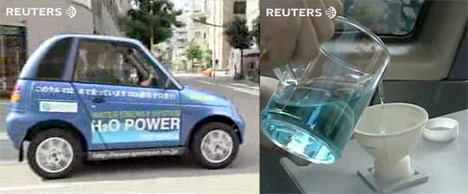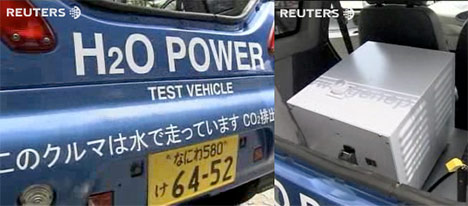Water Cars: Turn on your BS detector
Oil prices are high, and everybody's looking for a quick fix. People in the media know about this, so they are scrambling to find "energy" stories, and as always, many unscientific ones make it through.
In recent days, a "water-powered car" made by Genepax, a Japanese company, has been making the rounds, and even Reuters featured it.
I think it's important to explain why it is almost certainly not what it claims to be, or at least why with such extraordinary claims, we should wait for extraordinary evidence before being convinced that this is real.

Water is not an energy source, nor is hydrogen
So lets talk about water. Everybody knows it contains hydrogen, and that hydrogen can be burned or used to generate electricity in fuel cells. But what few people seem to realize is that hydrogen is not an energy source, at least not here on Earth. If we could go out and mine some pure hydrogen somehow, that would be an energy source. But we can't find any in pure form on this planet, so we either have to reform natural gas (and so here the energy source is fossil fuels, not the hydrogen itself), or we have to break up water molecules via electrolysis, a process that uses more energy as input than you can then get out of the hydrogen as output. That means that the hydrogen is just a carrier of energy - like a battery - and the real source is whatever you used to power the electrolysis process (so if you use wind power, your hydrogen car is actually powered by the wind via hydrogen).
Are they trying to sell us a perpetual motion machine?
Here's another way to think about it: When you burn a gallon of gasoline, none of the atoms in that fuel just disappear. They are only rearranged, so to speak, and that's what comes out of the exhaust. Carbon atoms combine with oxygen to form carbon monoxide and carbon dioxide, hydrogen combines with oxygen to form water vapor, sulphur forms sulphur oxides (SOx), etc.

"Water car" makers claim that you pour water in the tank, the car drives around, and the only thing coming out of the exhaust is water. So either all the water that goes in comes out of the exhaust, in which case why not loop it back straight to the water tank and voila, you've just raped the first law of thermodynamics and you have a perpetual motion machine! Or if less water comes out than goes in, where does the rest go? Is it destroyed? Do they claim to have a large particle accelerator in there? It just doesn't make any sense.
How they probably do it: Metal Hydrides
So how do they fake it for the television cameras? Some have probably just hidden batteries in the car, or a tank of hydrogen. But the most clever way to do it is with metal hydrides. If you are curious about them, I explain a bit more about they work, as well as why these stories create false hopes, real apathy and hurt the green movement, in this article: Genepax Water Car: Too Good to be True? Yeah.